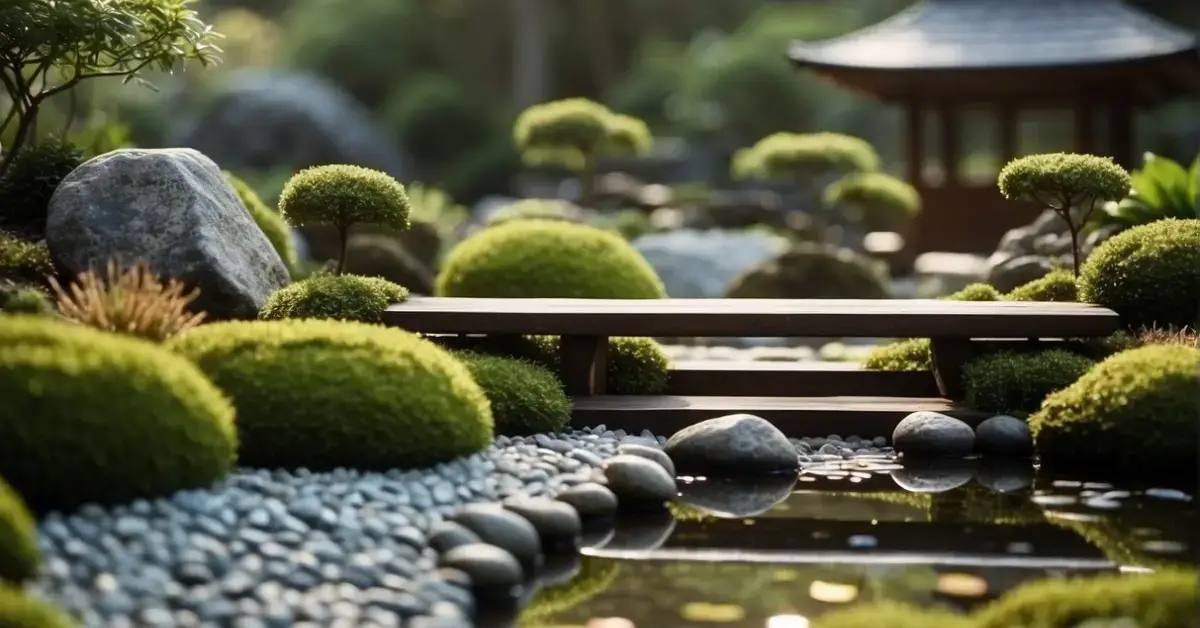Escape the chaos of daily life and find solace in the simplicity of a Zen Garden, where tranquility reigns supreme. From carefully arranged rocks to serene water features, explore how these gardens embody the principles of balance, harmony, and mindfulness, offering a serene space to pause, reflect, and find inner peace amidst the beauty of nature.
20+ Zen Garden Ideas




















Understanding Zen Gardens
As I explore the tranquil world of Zen gardens, I realize they are more than just a scenic beauty; they embody a profound spiritual philosophy. Originating in Japan, these meticulously arranged landscapes serve as physical expressions of Zen Buddhism and are designed to facilitate meditation and foster inner peace.
History and Philosophy
Zen gardens, also known as karesansui (dry landscape gardens), have a rich history that dates back to medieval Japan. They were often created by Buddhist monks as a means of aiding meditation and representing the minimalist aesthetics of Zen philosophy. The essence of a Zen garden is to capture the ephemeral nature of one’s own chi (energy) and the universe, reflecting the temporal form of life itself within the space of Japanese culture.
Elements and Symbolism
Every element in a Zen garden is symbolic, chosen with intention to represent nature’s elements and larger cosmic concepts. Let’s consider a few crucial elements:
- Rocks: Often the dominant feature, symbolizing mountains or islands.
- Sand or Gravel: Raked into patterns to represent water ripples or white space, offering a canvas for contemplation.
- Plants: Typically moss or pruned trees, signifying growth and endurance.
- Water: When present, it’s still and clear, encouraging reflection, both literal and metaphorical.
Design Principles
Creating a Zen garden follows specific design principles rooted in balance, simplicity, and naturalness. The principles encourage contemplating the true meaning behind every placement and object:
- Asymmetry (Fukinsei): Embraces irregularity and avoids artificial symmetry to keep the garden natural and soothing.
- Simplicity (Kanso): Involves minimalism, stripping the design to its essentials to bring clarity and purity to the meditative experience.
The garden layout often utilizes triangular arrangements of rocks, each carrying its weight and contributing to the unified message of harmony within the dry landscape. This disciplined approach encourages me to reflect deeply, moving past the chaos of everyday life into a state of serenity.
Creating Your Zen Garden

When I set out to create my Zen garden, I focus on careful selection of materials and precise layout to cultivate a space of tranquility. It’s all about harmonizing simplicity with nature.
Selecting Materials
I begin by choosing a base of gravel or sand, which will represent water in my Zen garden. Larger rocks and stones play a crucial role as well; they symbolize mountains and other natural landforms. A sturdy rake is essential for creating the ripples that mimic the effect of water.
- Base Materials: Fine gravel or sand
- Rocks/Stones: Select for size and character
- Rake: A tool with wide tines
Layout and Structure
A deliberate layout promotes a sense of peace in my Zen garden. I design my garden with asymmetry to create natural balance, opting for a stone path that guides through the serene landscape. Incorporating a fountain or a simple bamboo water feature adds a sensory layer with sound, enhancing the contemplative atmosphere. A bridge can be a beautiful focal point and symbolize the path to enlightenment.
- Paths: Winding stone path
- Water Feature: Bamboo fountain
- Focal Points: Bridges or large stones
Planting and Accessories
While my Zen garden is minimalist in nature, subtle planting accents, such as moss or low-lying shrubs, add life and complement the stone elements. Accessories like a bamboo rake or carefully placed lanterns enhance the garden’s aesthetic. Whether I include a few carefully selected plants or artistic stones, each element is chosen for its ability to contribute to the overall serenity of the garden.
- Plants: Mosses or low-lying shrubs
- Accessories: Lanterns, decorative rake
The Experience of Zen Gardens

When I step into a Zen garden, I’m instantly enveloped in an atmosphere of tranquility that aids in meditation and mindfulness. The careful maintenance and care of these gardens allow me to engage in the practice daily, bringing harmony and peace into my own life.
Meditation and Mindfulness
In the Zen garden, the simplicity of the stones and the raked sand patterns invite me to focus and slow down. I often find myself in a flow state, losing track of time as I sink into quiet contemplation. The minimalist design emphasizes the beauty of nature, allowing me to meditate with mindfulness as I become acutely aware of the surrounding serenity.
Maintenance and Care
The maintenance of a Zen garden is a practice of mindfulness in itself. For me, the methodical process of raking the sand and carefully placing each stone creates a rhythm that is both calming and centering. The garden thus mirrors the care I take with my own inner thoughts – each attended to dutifully, cultivating a landscape of internal harmony.
Incorporating into Daily Life
I’ve found much joy in bringing elements of Zen gardens into my daily life. Even without access to a full garden, simply arranging rocks on a tray filled with sand on my desk reminds me of the serene experience. This simple act helps me foster a calming, minimalist environment that echoes the beauty and simplicity of a traditional Zen garden.
FAQ – Zen Garden

What are the rules for a Zen garden?
Creating simplicity and serenity is key. A Zen garden should embody asymmetry to reflect natural landscapes, invoking calm and meditation. The principles of Zen gardening dictate that less is more; hence, stones, gravel, and sand are used more than plants, and each element is placed with intention and care.
What is special about a Zen garden?
A Zen garden captures the essence of nature through minimalistic design and symbolic elements. Its special quality lies in its ability to foster peace and introspection. The distinctiveness comes from careful composition that facilitates a space for meditation and reflection, as explained by Japan’s foremost Zen authority D.T. Suzuki.
How many plants can you have in Zen garden?
In my Zen garden, I generally have very few plants, often just enough to complement the stones and sand. Think of plants as highlights rather than main features; popular choices might include an elegantly shaped Japanese maple or moss which adds a touch of green, symbolizing islands or mountains in the sea of sand.
If you liked this blog post about the topic: Zen Garden, don’t forget to leave me a comment down below to tell me about your experience with it. Or have a look at my other articles:

